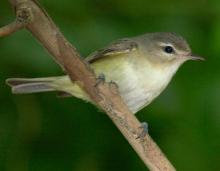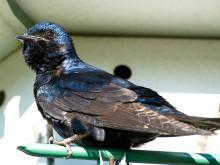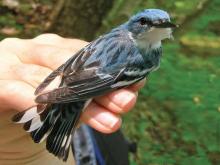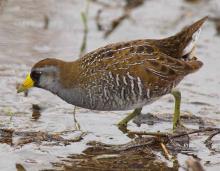Birds
Media

Species Types
Scientific Name
Setophaga dominica (formerly Dendroica dominica)
Description
The yellow-throated warbler creeps along branches high in the tops of trees, searching the bark for insects. Listen for its distinctive song, a cascade of clearly whistled tew notes.
Media

Species Types
Scientific Name
Vireo griseus
Description
The white-eyed vireo’s white irises would seem its most distinctive feature, but it’s actually better known for its distinctive, loud, vociferous song.
Media

Species Types
Scientific Name
Vireo gilvus
Description
The warbling vireo is a drab little bird with a colorful, brilliant song. It’s a common summer resident. Listen for it in forests, woodlands, and suburbs, especially in large trees near water.
Media

Species Types
Scientific Name
Coccothraustes vespertinus
Description
Evening grosbeaks are sporadically present in Missouri — flocks sometimes wander here from the north during winter. When flocks appear at backyard birdfeeders, it creates a local sensation.
Media

Species Types
Scientific Name
Scolopax minor
Description
This remarkable bird is a short-necked, short-legged, terrestrial shorebird with a long bill. The eyes are set back on its head. When this bird is flushed, its short wings make a startling whirring sound.
Media

Species Types
Scientific Name
Chaetura pelagica
Description
About the only way to see chimney swifts — unless you look in a chimney flue — is while they’re flying. They look like “flying cigars,” with long narrow wings, and chitter loudly as they fly.
Media

Species Types
Scientific Name
Progne subis
Description
Generations of Americans have greeted the annual return of purple martins, with their cheerful calls, graceful flight, and faithful reappearance each year. But martin populations have been declining. Find out what you can do to help these agile fliers.
Media

Species Types
Scientific Name
Setophaga cerulea (formerly Dendroica cerulea)
Description
A summer resident in Missouri, the cerulean warbler is more common in the southeastern Ozarks but rare elsewhere in the state. Its numbers are small and declining, and for that reason our nation may soon classify it as endangered.
Media

Species Types
Scientific Name
Anas strepera
Description
The male gadwall is a rather drab-looking duck with a black rear end and a white speculum (wing patch). This dabbling duck is a common migrant in Missouri.
Media

Species Types
Scientific Name
Porzana carolina
Description
The sora looks something like a tiny, dark hen. A common migrant and rare summer resident in Missouri, this rail forages in marshes, swamps, wet pastures, and flooded fields.
See Also







Media

Species Types
Scientific Name
Hemaris diffinis
Description
The snowberry clearwing is a moth that confuses people because it looks like a bumblebee and flies like a hummingbird!
Media

Species Types
Scientific Name
Hyles lineata
Description
The white-lined sphinx moth sometimes confuses people because it flies, hovers, and eats from flowers like a hummingbird. The adults often fly during daylight hours as well as in the night and are often found at lights.
Media

Species Types
Scientific Name
Darapsa myron
Description
The Virginia creeper sphinx moth is common in woods and brushy areas and comes to lights at night. The larvae eat Virginia creeper and grape leaves.
Media

Species Types
Scientific Name
Perimyotis subflavus (formerly Pipistrellus subflavus)
Description
Tri-colored bats, formerly called eastern pipistrelles, are relatively small and look pale yellowish or pale reddish brown. The main hairs are dark gray at the base, broadly banded with yellowish brown, and tipped with dark brown.
Media

Species Types
Scientific Name
Myotis grisescens
Description
Gray myotises are difficult to distinguish from other mouse-eared bats. A key identifying feature of the gray myotis is that its wing is attached to the ankle and not at the base of the toes. It’s an endangered species.
Media

Species Types
Scientific Name
Myotis lucifugus
Description
The little brown myotis (little brown bat) is one of our most common bats, but populations are declining. White-nose syndrome has taken a heavy toll in northeastern states. This species is now listed as vulnerable across its range.
Media

Species Types
Scientific Name
Myotis sodalis
Description
The Indiana myotis, or Indiana bat, summers along streams and rivers in north Missouri, raising its young under the bark of certain trees. It is an endangered species.
About Birds in Missouri
About 350 species of birds are likely to be seen in Missouri, though nearly 400 have been recorded within our borders. Most people know a bird when they see one — it has feathers, wings, and a bill. Birds are warm-blooded, and most species can fly. Many migrate hundreds or thousands of miles. Birds lay hard-shelled eggs (often in a nest), and the parents care for the young. Many communicate with songs and calls.





















